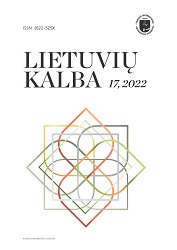Anoniminio katekizmo (1605) ir Daukšos katekizmo (1595) skolintų daiktavardžių integravimas į lietuvių kalbos morfologinę sistemą
Integration of loan nouns from the Anonymous Catechism (1605) and Daukša’s Catechism (1595) into the morphological system of the Lithuanian language
Author(s): Anželika SmetonienėSubject(s): Morphology, Lexis, Historical Linguistics, Baltic Languages
Published by: Vilniaus Universiteto Leidykla
Keywords: Anonymous Catechism; Catechism of Daukša; Slavic loanwords; stem; morphological integration;
Summary/Abstract: The Catechism of Daukša (1595) is the first source in the Lithuanian language in GDL and, therefore, it has been already investigated: its phonetics, vocabulary, sources and syntax have been exhaustively analysed. Slightly less attention of the researchers has been allocated to the Anonymous Catechism (1605), which is closely linked to the Catechism written by Daukša. Moreover, morphological integration of Slavic loanwords in the aforesaid catechisms has not been analysed so far. This article aims to identify how Slavic loan nouns distribute within the stems of the Lithuanian language and if these sources witness any differences of integrating Slavic loanwords into Lithuanian. Pursuing the set goal, all Slavic loan words were selected from both catechisms: out of 93 nouns found, 35 are witnessed in the Daukša’s Catechism and Anonymous Catechism and their stems and meanings are identified. The nouns are found in almost all the Lithuanian stems: ŏ, i̯ŏ, ā, i̯ā, u, i̯u, i, ē, the ŏ and ā stems being most numerous. Very few Slavic loanwords are assigned to the stems i, u, ē and i̯ŏ. In the dictionaries of the Slavic languages of the relevant period (Old Russian, Ruthenian, Old and Middle Polish), the equivalents of Slavicisms were searched, after comparing them with Lithuanian words, the regularities of the integration of Slavic loanwords into the morphological system of the Lithuanian language were determined in the Anonymous Catechism and the Catechism of Daukša. It was noticed that there is a direct relation between the endings and the gender of the Slavic words and Lithuanian stems that the Slavic loanwords were integrated into.
Journal: Lietuvių kalba
- Issue Year: 2022
- Issue No: 17
- Page Range: 25-38
- Page Count: 14
- Language: Lithuanian

